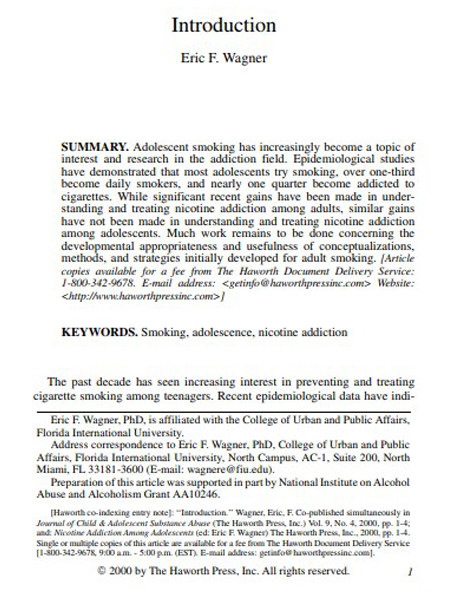Publications
Introduction, Journal of Child & Adolescent Substance Abuse
Smoking among teenage girls
Smoking among teenage girls
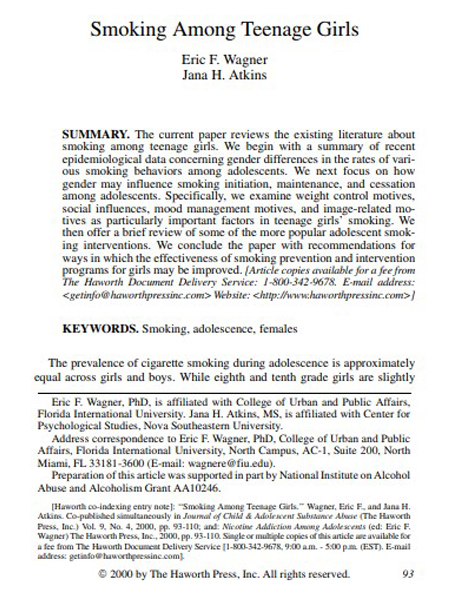 Abstract: The current paper reviews the existing literature about smoking among teenage girls. We begin with a summary of recent epidemiological data concerning gender differences in the rates of various smoking behaviors among adolescents. We next focus on how gender may influence smoking initiation, maintenance, and cessation among adolescents. Specifically, we examine weight control motives, social influences, mood management motives, and image-related motives as particularly important factors in teenage girls’ smoking. We then offer a brief review of some of the more popular adolescent smoking interventions. We conclude the paper with recommendations for ways in which the effectiveness of smoking prevention and intervention programs for girls may be improved.
Abstract: The current paper reviews the existing literature about smoking among teenage girls. We begin with a summary of recent epidemiological data concerning gender differences in the rates of various smoking behaviors among adolescents. We next focus on how gender may influence smoking initiation, maintenance, and cessation among adolescents. Specifically, we examine weight control motives, social influences, mood management motives, and image-related motives as particularly important factors in teenage girls’ smoking. We then offer a brief review of some of the more popular adolescent smoking interventions. We conclude the paper with recommendations for ways in which the effectiveness of smoking prevention and intervention programs for girls may be improved.
Wagner, E.F., & Atkins, J.H. (2000). Smoking among teenage girls. Journal of Child & Adolescent Substance Abuse, 9(4), 93. doi:10.1300/J029v09n04_06
Stress-coping and temptation-coping as predictors of adolescent substance use
Stress-coping and temptation-coping as predictors of adolescent substance use
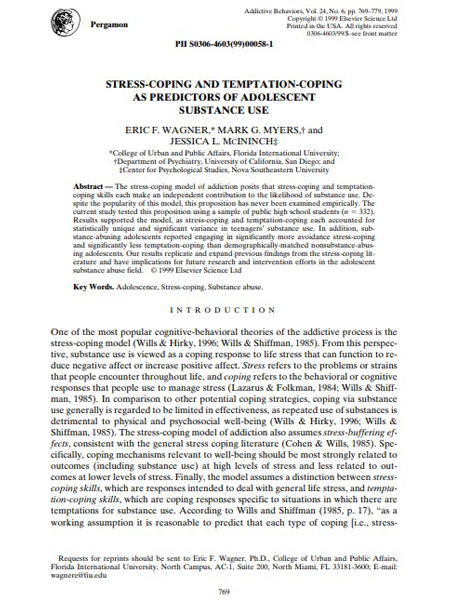 Abstract: The stress-coping model of addiction posits that stress-coping and temptation-coping skills each make an independent contribution to the likelihood of substance use. Despite the popularity of this model, this proposition has never been examined empirically. The current study tested this proposition using a sample of public high school students (n = 332). Results supported the model, as stress-coping and temptation-coping each accounted for statistically unique and significant variance in teenagers’ substance use. In addition, substance-abusing adolescents reported engaging in significantly more avoidance stress-coping and significantly less temptation-coping than demographically-matched nonsubstance-abusing adolescents. Our results replicate and expand previous findings from the stress-coping literature and have implications for future research and intervention efforts in the adolescent substance abuse field.
Abstract: The stress-coping model of addiction posits that stress-coping and temptation-coping skills each make an independent contribution to the likelihood of substance use. Despite the popularity of this model, this proposition has never been examined empirically. The current study tested this proposition using a sample of public high school students (n = 332). Results supported the model, as stress-coping and temptation-coping each accounted for statistically unique and significant variance in teenagers’ substance use. In addition, substance-abusing adolescents reported engaging in significantly more avoidance stress-coping and significantly less temptation-coping than demographically-matched nonsubstance-abusing adolescents. Our results replicate and expand previous findings from the stress-coping literature and have implications for future research and intervention efforts in the adolescent substance abuse field.
Wagner, E.F., Myers, M.G., & Mcininch, J.L. (1999). Stress-coping and temptation-coping as predictors of adolescent substance use. Addictive Behaviors, 24(6), 769-779. doi:10.1016/s0306-4603(99)00058-1
Cross-validation of the Temptation Coping Questionnaire: Adolescent coping with temptations to use alcohol and illicit drugs
Cross-validation of the Temptation Coping Questionnaire: Adolescent coping with temptations to use alcohol and illicit drugs
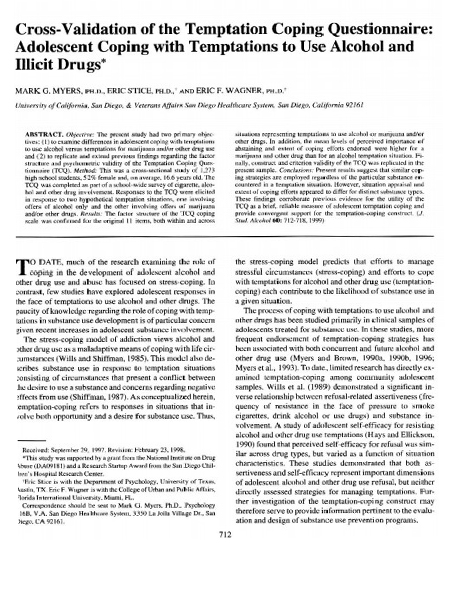 Abstract: The present study had two primary objectives: (1) to examine differences in adolescent coping with temptations to use alcohol versus temptations for marijuana and/or other drug use and (2) to replicate and extend previous findings regarding the factor structure and psychometric validity of the Temptation Coping Questionnaire (TCQ). This was a cross-sectional study of 1,273 high school students, 52% female and, on average, 16.6 years old. The TCQ was completed as part of a school-wide survey of cigarette, alcohol and other drug involvement. Responses to the TCQ were elicited in response to two hypothetical temptation situations, one involving offers of alcohol only and the other involving offers of marijuana and/or other drugs. The factor structure of the TCQ coping scale was confirmed for the original 11 items, both within and across situations representing temptations to use alcohol or marijuana and/or other drugs. In addition, the mean levels of perceived importance of abstaining and extent of coping efforts endorsed were higher for a marijuana and other drug than for an alcohol temptation situation. Finally, construct and criterion validity of the TCQ was replicated in the present sample. Present results suggest that similar coping strategies are employed regardless of the particular substance encountered in a temptation situation. However, situation appraisal and extent of coping efforts appeared to differ for distinct substance types. These findings corroborate previous evidence for the utility of the TCQ as a brief, reliable measure of adolescent temptation coping and provide convergent support for the temptation-coping construct.
Abstract: The present study had two primary objectives: (1) to examine differences in adolescent coping with temptations to use alcohol versus temptations for marijuana and/or other drug use and (2) to replicate and extend previous findings regarding the factor structure and psychometric validity of the Temptation Coping Questionnaire (TCQ). This was a cross-sectional study of 1,273 high school students, 52% female and, on average, 16.6 years old. The TCQ was completed as part of a school-wide survey of cigarette, alcohol and other drug involvement. Responses to the TCQ were elicited in response to two hypothetical temptation situations, one involving offers of alcohol only and the other involving offers of marijuana and/or other drugs. The factor structure of the TCQ coping scale was confirmed for the original 11 items, both within and across situations representing temptations to use alcohol or marijuana and/or other drugs. In addition, the mean levels of perceived importance of abstaining and extent of coping efforts endorsed were higher for a marijuana and other drug than for an alcohol temptation situation. Finally, construct and criterion validity of the TCQ was replicated in the present sample. Present results suggest that similar coping strategies are employed regardless of the particular substance encountered in a temptation situation. However, situation appraisal and extent of coping efforts appeared to differ for distinct substance types. These findings corroborate previous evidence for the utility of the TCQ as a brief, reliable measure of adolescent temptation coping and provide convergent support for the temptation-coping construct.
Myers, M.G., Stice, E., & Wagner, E.F. (1999). Cross-validation of the Temptation Coping Questionnaire: Adolescent coping with temptations to use alcohol and illicit drugs. Journal of Studies on Alcohol, 60(5), 712-718. doi:10.15288/jsa.1999.60.712
Innovations in adolescent substance abuse intervention
Innovations in adolescent substance abuse intervention
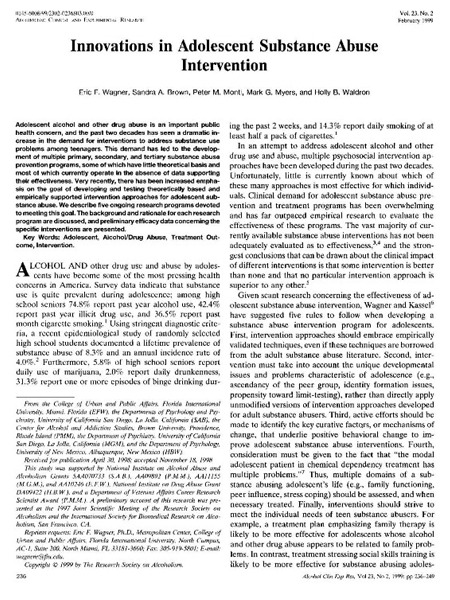 Abstract: Adolescent alcohol and other drug abuse is an important public health concern, and the past two decades has seen a dramatic increase in the demand for interventions to address substance use problems among teenagers. This demand has led to the development of multiple primary, secondary, and tertiary substance abuse prevention programs, some of which have little theoretical basis and most of which currently operate in the absence of data supporting their effectiveness. Very recently, there has been increased emphasis on the goal of developing and testing theoretically based and empirically supported intervention approaches for adolescent substance abuse. We describe five ongoing research programs devoted to meeting this goal. The background and rationale for each research program are discussed, and preliminary efficacy data concerning the specific interventions are presented.
Abstract: Adolescent alcohol and other drug abuse is an important public health concern, and the past two decades has seen a dramatic increase in the demand for interventions to address substance use problems among teenagers. This demand has led to the development of multiple primary, secondary, and tertiary substance abuse prevention programs, some of which have little theoretical basis and most of which currently operate in the absence of data supporting their effectiveness. Very recently, there has been increased emphasis on the goal of developing and testing theoretically based and empirically supported intervention approaches for adolescent substance abuse. We describe five ongoing research programs devoted to meeting this goal. The background and rationale for each research program are discussed, and preliminary efficacy data concerning the specific interventions are presented.
Wagner, E.F., Brown, S.A., Monti, P.M., Myers, M.G., & Waldron, H.B. (1999). Innovations in adolescent substance abuse intervention. Alcoholism: Clinical & Experimental Research, 23(2), 236-249. doi:10.1097/00000374-199902000-00008
Anticipated mortality, HIV vulnerability, and psychological distress among adolescents and young adults at higher and lower risk for HIV infection
Anticipated mortality, HIV vulnerability, and psychological distress among adolescents and young adults at higher and lower risk for HIV infection
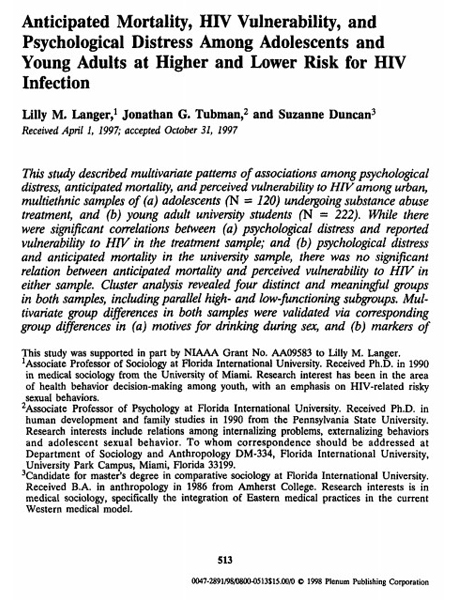 Abstract: This study described multivariate patterns of associations among psychological distress, anticipated mortality, and perceived vulnerability to HIV among urban, multiethnic samples of (a) adolescents (N = 120) undergoing substance abuse treatment, and (b) young adult university students (N = 222). While there were significant correlations between (a) psychological distress and reported vulnerability to HIV in the treatment sample; and (b) psychological distress and anticipated mortality in the university sample, there was no significant relation between anticipated mortality and perceived vulnerability to HIV in either sample. Cluster analysis revealed four distinct and meaningful groups in both samples, including parallel high- and low-functioning subgroups. Multivariate group differences in both samples were validated via corresponding group differences in (a) motives for drinking during sex, and (b) markers of serious psychological distress (e.g., suicidal thoughts and attempts). The findings challenge popular sterotpes of adolescents’ perceptions of their own mortality and vulnerability to HIV and may have significant implications for the planning and implementation of effective HIV preventions among at-risk youth.
Abstract: This study described multivariate patterns of associations among psychological distress, anticipated mortality, and perceived vulnerability to HIV among urban, multiethnic samples of (a) adolescents (N = 120) undergoing substance abuse treatment, and (b) young adult university students (N = 222). While there were significant correlations between (a) psychological distress and reported vulnerability to HIV in the treatment sample; and (b) psychological distress and anticipated mortality in the university sample, there was no significant relation between anticipated mortality and perceived vulnerability to HIV in either sample. Cluster analysis revealed four distinct and meaningful groups in both samples, including parallel high- and low-functioning subgroups. Multivariate group differences in both samples were validated via corresponding group differences in (a) motives for drinking during sex, and (b) markers of serious psychological distress (e.g., suicidal thoughts and attempts). The findings challenge popular sterotpes of adolescents’ perceptions of their own mortality and vulnerability to HIV and may have significant implications for the planning and implementation of effective HIV preventions among at-risk youth.
Langer, L.M., Tubman, J.G., & Duncan, S. (1998). Anticipated mortality, HIV vulnerability, and psychological distress among adolescents and young adults at higher and lower risk for HIV infection. Journal of Youth and Adolescence, 27(4), 513-538. doi:10.1023/a:1022856203755
Temporal influences of family structure and family risk factors on drug use initiation in a multiethnic sample of adolescent boys
Temporal influences of family structure and family risk factors on drug use initiation in a multiethnic sample of adolescent boys
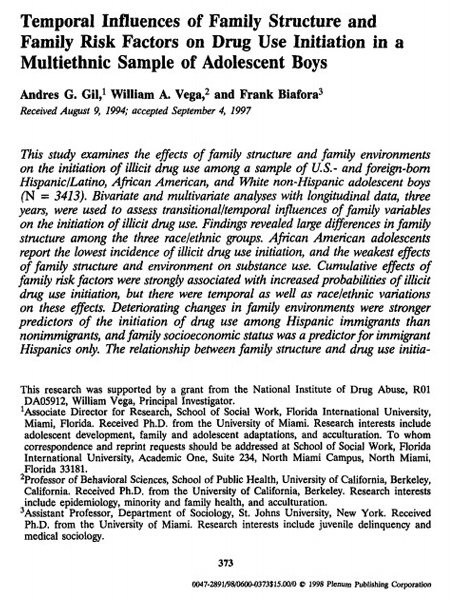 Abstract: This study examines the effects of family structure and family environments on the initiation of illicit drug use among a sample of U.S.- and foreign-born Hispanic/Latino, African American, and White non-Hispanic adolescent boys (N = 3413). Bivariate and multivariate analyses with longitudinal data, three years, were used to assess transitional/temporal influences of family variables on the initiation of illicit drug use. Findings revealed large differences in family structure among the three race/ethnic groups. African American adolescents report the lowest incidence of illicit drug use initiation, and the weakest effects of family structure and environment on substance use. Cumulative effects of family risk factors were strongly associated with increased probabilities of illicit drug use initiation, but there were temporal as well as race/ethnic variations on these effects. Deteriorating changes in family environments were stronger predictors of the initiation of drug use among Hispanic immigrants than nonimmigrants, and family socioeconomic status was a predictor for immigrant Hispanics only. The relationship between family structure and drug use initiation varied in the context of temporal indicators of family environments, and the accumulation of family risk factors was a stronger predictor of illicit drug initiation than family structure.
Abstract: This study examines the effects of family structure and family environments on the initiation of illicit drug use among a sample of U.S.- and foreign-born Hispanic/Latino, African American, and White non-Hispanic adolescent boys (N = 3413). Bivariate and multivariate analyses with longitudinal data, three years, were used to assess transitional/temporal influences of family variables on the initiation of illicit drug use. Findings revealed large differences in family structure among the three race/ethnic groups. African American adolescents report the lowest incidence of illicit drug use initiation, and the weakest effects of family structure and environment on substance use. Cumulative effects of family risk factors were strongly associated with increased probabilities of illicit drug use initiation, but there were temporal as well as race/ethnic variations on these effects. Deteriorating changes in family environments were stronger predictors of the initiation of drug use among Hispanic immigrants than nonimmigrants, and family socioeconomic status was a predictor for immigrant Hispanics only. The relationship between family structure and drug use initiation varied in the context of temporal indicators of family environments, and the accumulation of family risk factors was a stronger predictor of illicit drug initiation than family structure.
Gil, A.G., Vega, W.A., & Biafora, F. (1998). Temporal influences of family structure and family risk factors on drug use initiation in a multiethnic sample of adolescent boys. Journal of Youth and Adolescence, 27(3), 373-393. doi:10.1023/A:1022807221074
Substance use and violent behavior in adolescence
Substance use and violent behavior in adolescence
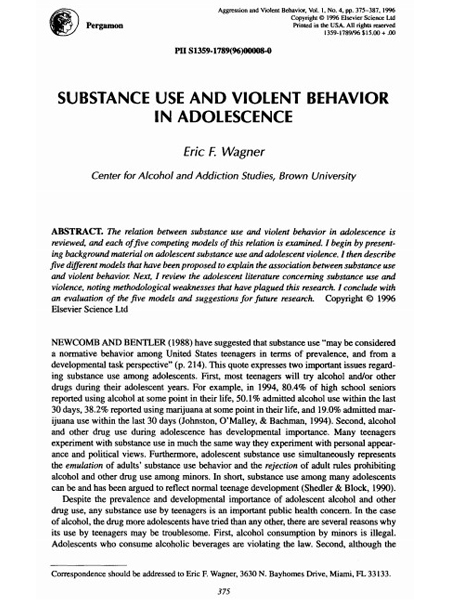 Abstract: The relation between substance use and violent behavior in adolescence is reviewed, and each of five competing models of this relation is examined. I begin by presenting background material on adolescent substance use and adolescent violence. I then describe five different models that have been proposed to explain the association between substance use and violent behavior. Next, I review the adolescent literature concerning substance use and violence, noting methodological weaknesses that have plagued this research. I conclude with an evaluation of the five models and suggestions for future research.
Abstract: The relation between substance use and violent behavior in adolescence is reviewed, and each of five competing models of this relation is examined. I begin by presenting background material on adolescent substance use and adolescent violence. I then describe five different models that have been proposed to explain the association between substance use and violent behavior. Next, I review the adolescent literature concerning substance use and violence, noting methodological weaknesses that have plagued this research. I conclude with an evaluation of the five models and suggestions for future research.
Wagner, E.F. (1996). Substance use and violent behavior in adolescence. Aggression and Violent Behavior,1(4), 375-387. doi:10.1016/s1359-1789(96)00008-0
The temptation-coping questionnaire: Development and validation
The temptation-coping questionnaire: Development and validation
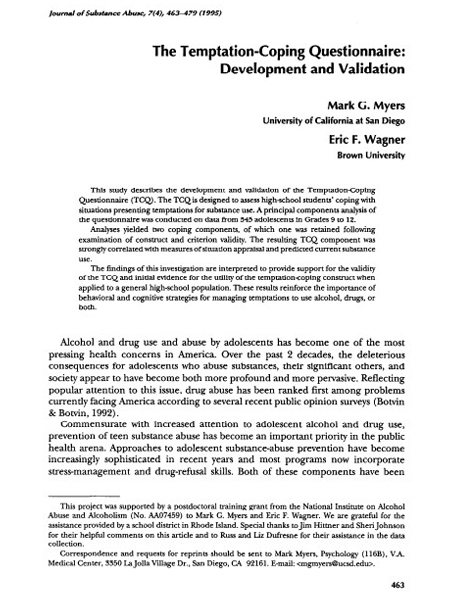 Abstract: This study describes the development and validation of the Temptation-Coping Questionnaire (TCQ). The TCQ is designed to assess high-school students’ coping with situations presenting temptations for substance use. A principal components analysis of the questionnaire was conducted on data from 545 adolescents in Grades 9 to 12. Analyses yielded two coping components, of which one was retained following examination of construct and criterion validity. The resulting TCQ component was strongly correlated with measures of situation appraisal and predicted current substance use. The findings of this investigation are interpreted to provide support for the validity of the TCQ and initial evidence for the utility of the temptation-coping construct when applied to a general high-school population. These results reinforce the importance of behavioral and cognitive strategies for managing temptations to use alcohol, drugs, or both.
Abstract: This study describes the development and validation of the Temptation-Coping Questionnaire (TCQ). The TCQ is designed to assess high-school students’ coping with situations presenting temptations for substance use. A principal components analysis of the questionnaire was conducted on data from 545 adolescents in Grades 9 to 12. Analyses yielded two coping components, of which one was retained following examination of construct and criterion validity. The resulting TCQ component was strongly correlated with measures of situation appraisal and predicted current substance use. The findings of this investigation are interpreted to provide support for the validity of the TCQ and initial evidence for the utility of the temptation-coping construct when applied to a general high-school population. These results reinforce the importance of behavioral and cognitive strategies for managing temptations to use alcohol, drugs, or both.
Myers, M.G., & Wagner, E.F. (1995). The temptation-coping questionnaire: Development and validation. Journal of Substance Abuse, 7(4), 463-479. doi:10.1016/0899-3289(95)90016-0
Validation of the Teen Addiction Severity Index (T-ASI):Preliminary findings
Validation of the Teen Addiction Severity Index (T-ASI): Preliminary findings
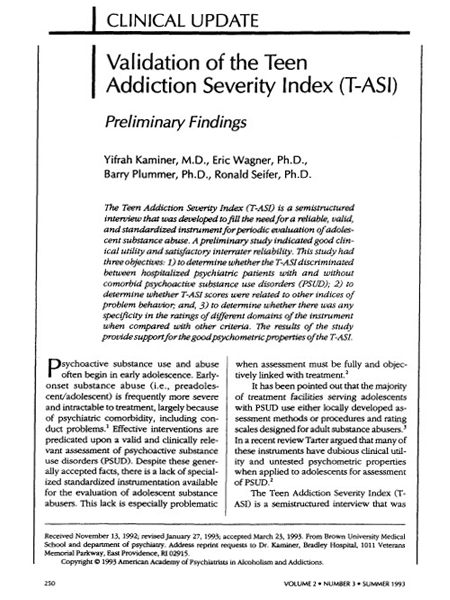 Abstract: The Teen Addiction Severity Index (T-ASI) is a semistructured interview that was developed to fill the need for a reliable, valid, and standardized instrument for periodic evaluation of adolescent substance abuse. A preliminary study indicated good clinical utility and satisfactory interrater reliability. This study had three objectives: 1) to determine whether the T-ASI discriminated between hospitalized psychiatric patients with and without comorbid psychoactive substance use disorders (PSUD); 2) to determine whether T-ASI scores were related to other indices of problem behavior; and, 3) to determine whether there was any specificity in the ratings of different domains of the instrument when compared with other criteria. The results of the study provide support for the good psychometric properties of the T-ASI.
Abstract: The Teen Addiction Severity Index (T-ASI) is a semistructured interview that was developed to fill the need for a reliable, valid, and standardized instrument for periodic evaluation of adolescent substance abuse. A preliminary study indicated good clinical utility and satisfactory interrater reliability. This study had three objectives: 1) to determine whether the T-ASI discriminated between hospitalized psychiatric patients with and without comorbid psychoactive substance use disorders (PSUD); 2) to determine whether T-ASI scores were related to other indices of problem behavior; and, 3) to determine whether there was any specificity in the ratings of different domains of the instrument when compared with other criteria. The results of the study provide support for the good psychometric properties of the T-ASI.
Kaminer, Y., Wagner, E.F., Plummer, B., & Seifer, R. (1993). Validation of the Teen Addiction Severity Index (T-ASI): Preliminary findings. American Journal on Addictions, 2(3), 250-254. doi: 10.3109/10550499309113946

